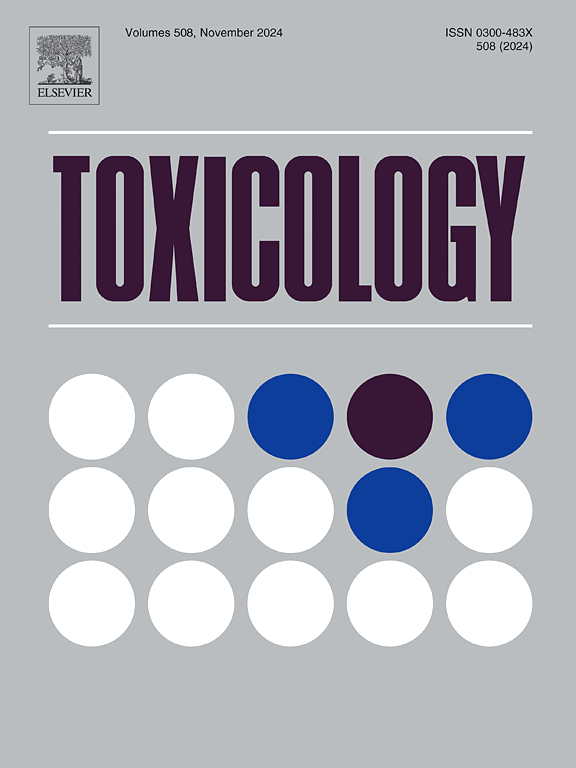Ferroptosis contributing to spermatocyte injury induced by silica nanoparticles via BRCA1/GPX4 signaling
IF 4.6
3区 医学
Q1 PHARMACOLOGY & PHARMACY
引用次数: 0
Abstract
Amorphous silica nanoparticles (SiNPs) have gradually been established to pose a threat to male reproductive health, but the underlying mechanisms are not yet fully elucidated. Ferroptosis is an emerging programmed cell death mechanism associated with spermatogenic disorders. Here, we examined how ferroptosis contributes to SiNP-induced male reproductive damage and assessed the regulatory role of the BRCA1/GPX4 axis in this context. GC-2spd cells were exposure to SiNPs with concentrations of 0, 10, and 20 μg/mL and RNA sequencing of GC-2spd cells was performed. Follow-up experiments were performed to validate the enrichment analysis findings. According to the bioinformatic analysis, after exposure to SiNPs, oxidative stress, ferroptosis and cell cycle pathway were markedly enriched. SiNPs triggered iron overload and significantly decreased the expression levels of glutathione peroxidase 4 (GPX4) and glutathione (GSH) in GC-2spd cells, while upregulating malondialdehyde (MDA) and heme oxygenase-1 (HO-1). Of particular note, the ferroptosis inhibitor Ferrostatin-1 (Fer-1) and a potent iron chelator deferoxamine (DFO) attenuated SiNPs-induced lipid peroxidation, iron overload and cytotoxicity. Of mechanistic importance, we found that BRCA1 targeted GPX4 as a pivotal factor in mediating ferroptosis triggered by SiNPs. Curcumin, the specifical activator of BRCA1, treatment significantly alleviate SiNPs-stimulated down-regulation on expressions of BRCA1 and GPX4. Our findings first emphasize that BRCA1/GPX4 signal-mediated ferroptosis was a factor in SiNPs-caused spermatocyte injury, which offers novel insights for clarifying the toxicity of SiNPs and for the safe application of SiNPs-related nanoproducts in the future.
二氧化硅纳米颗粒通过BRCA1/GPX4信号通路诱导精母细胞损伤
无定形二氧化硅纳米颗粒(SiNPs)对男性生殖健康的威胁已逐渐确立,但其潜在机制尚未完全阐明。铁下垂是一种新兴的与生精障碍相关的程序性细胞死亡机制。在这里,我们研究了铁下沉如何导致sinp诱导的男性生殖损伤,并评估了BRCA1/GPX4轴在这种情况下的调节作用。将GC-2spd细胞暴露于浓度为0、10和20 μg/mL的SiNPs中,对GC-2spd细胞进行RNA测序。进行后续实验以验证富集分析结果。生物信息学分析表明,暴露于SiNPs后,氧化应激、铁下垂和细胞周期通路显著增强。SiNPs引发铁超载,显著降低GC-2spd细胞中谷胱甘肽过氧化物酶4 (GPX4)和谷胱甘肽(GSH)的表达水平,上调丙二醛(MDA)和血红素氧合酶1 (HO-1)。特别值得注意的是,铁下垂抑制剂铁抑素-1 (fer1)和强效铁螯合剂去铁胺(DFO)减弱了sinps诱导的脂质过氧化、铁过载和细胞毒性。在机制上,我们发现BRCA1靶向GPX4作为介导SiNPs引发的铁凋亡的关键因子。姜黄素是BRCA1的特异性激活剂,处理后可显著缓解sinps刺激的BRCA1和GPX4表达下调。我们的研究结果首先强调了BRCA1/GPX4信号介导的铁凋亡是SiNPs引起的精母细胞损伤的一个因素,这为阐明SiNPs的毒性以及未来SiNPs相关纳米产品的安全应用提供了新的见解。
本文章由计算机程序翻译,如有差异,请以英文原文为准。
求助全文
约1分钟内获得全文
求助全文
来源期刊

Toxicology
医学-毒理学
CiteScore
7.80
自引率
4.40%
发文量
222
审稿时长
23 days
期刊介绍:
Toxicology is an international, peer-reviewed journal that publishes only the highest quality original scientific research and critical reviews describing hypothesis-based investigations into mechanisms of toxicity associated with exposures to xenobiotic chemicals, particularly as it relates to human health. In this respect "mechanisms" is defined on both the macro (e.g. physiological, biological, kinetic, species, sex, etc.) and molecular (genomic, transcriptomic, metabolic, etc.) scale. Emphasis is placed on findings that identify novel hazards and that can be extrapolated to exposures and mechanisms that are relevant to estimating human risk. Toxicology also publishes brief communications, personal commentaries and opinion articles, as well as concise expert reviews on contemporary topics. All research and review articles published in Toxicology are subject to rigorous peer review. Authors are asked to contact the Editor-in-Chief prior to submitting review articles or commentaries for consideration for publication in Toxicology.
 求助内容:
求助内容: 应助结果提醒方式:
应助结果提醒方式:


